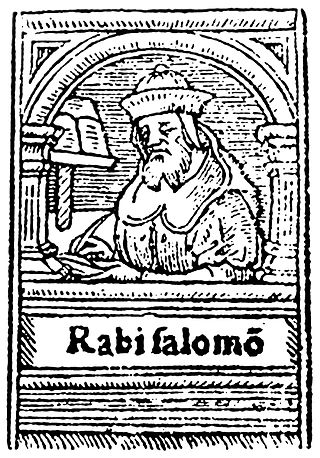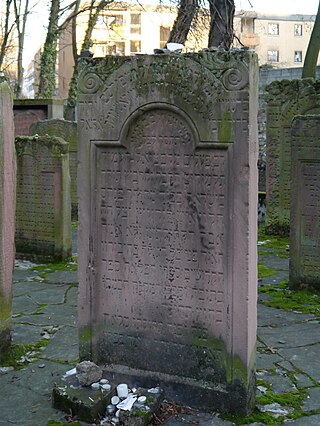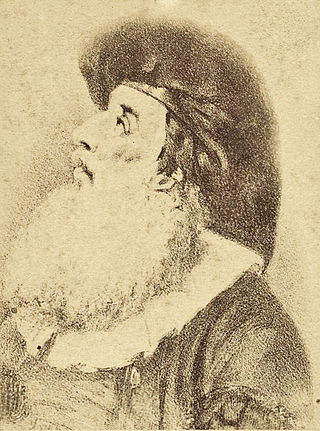Related Research Articles

Shlomo Yitzchaki, generally known by the acronym Rashi, was a medieval French rabbi, the author of comprehensive commentaries on the Talmud and Hebrew Bible.

Rabbinic literature, in its broadest sense, is the entire spectrum of rabbinic writings throughout Jewish history. However, the term often refers specifically to literature from the Talmudic era, as opposed to medieval and modern rabbinic writings, and thus corresponds with the Hebrew term Sifrut Chazal. This more specific sense of "Rabbinic literature"—referring to the Talmudim, Midrashim, and related writings, but hardly ever to later texts—is how the term is generally intended when used in contemporary academic writing. The terms mefareshim and parshanim (commentaries/commentators) almost always refer to later, post-Talmudic writers of rabbinic glosses on Biblical and Talmudic texts.

Isaiah or Yeshayahu ben Avraham Ha-Levi Horowitz, , also known as the Shelah HaKaddosh after the title of his best-known work, was a prominent rabbi and mystic.
Samuel ben Meir, after his death known as the "Rashbam", a Hebrew acronym for RAbbi SHmuel Ben Meir, was a leading French Tosafist and grandson of Shlomo Yitzhaki, "Rashi".
Tobiah ben Eliezer was a Talmudist and poet of the 11th century, author of Lekach Tov or Pesikta Zutarta, a midrashic commentary on the Pentateuch and the Five Megillot.
Benjamin ben Abraham Anaw was a Roman Jewish liturgical poet, Talmudist, and commentator of the thirteenth century, and older brother of Zedekiah ben Abraham Anaw.

Nehemiah Brüll was a rabbi and versatile scholar.
"Wissenschaft des Judentums" refers to a nineteenth-century movement premised on the critical investigation of Jewish literature and culture, including rabbinic literature, to analyze the origins of Jewish traditions.

Rabbi Pinchas HaLevi Horowitz, also known as the Baal Hafla'ah, was a rabbi and Talmudist.
Hezekiah ben Manoah, or Hezekiah bar Manoah, was a French rabbi and Bible commentator of the 13th century. He is generally known by the title of his commentary, Chizkuni.
Aaron Samuel ben Israel Kaidanover was a Polish-Lithuanian rabbi. Among his teachers were Jacob Hoeschel and his son Joshua Hoeschel.

Naphtali Cohen (1649–1718), also known as Naphtali HaKohen Katz, was a Russo-German rabbi and kabalist born in Ostrowo in Ukraine. He belonged to a family of rabbis in Ostrowo, where his father, Isaac Cohen, a great-great-grandson of the Judah Loew ben Bezalel, had fled during the Polish–Cossack–Tatar War.

Joseph ben Meir Teomim was a Galician Rabbi, best known as author of Pri Megadim, by which title he is also referenced. He was one of the foremost Torah Scholars of his time, a "thorough student of rabbinical literature, and... not unlearned in the secular sciences".
Naphtali Hirz (Hartwig) Wessely was a German-Jewish Hebraist and educationist.

Pirkei de-Rabbi Eliezer is an aggadic-midrashic work on the Torah containing exegesis and retellings of biblical stories.
Yom-Tov Lipmann ben Solomon Muhlhausen was a controversial Talmudist, kabalist and philosopher of the 14th and 15th centuries. His religious and scholarly career and influence spanned the Jewish communities of Bohemia, Poland, Austria and various parts of Germany, and his dispute with the principles of Christianity left a lasting imprint on the relations between Christianity and Judaism.
Henry Malter was an American rabbi and scholar.
Elijah ben Moses Ashkenazi Loans also known as Elijah Baal Shem of Worms was a German rabbi and Kabbalist.
Meir ben Samuel, also known by the Hebrew acronym RaM for Rabbi Meir, was a French rabbi and tosafist, who was born in about 1060 in Ramerupt, and died after 1135. His father was an eminent scholar. Meir received his education in the Talmudical schools of Lorraine, his principal teachers being Isaac ben Asher ha-Levi and Eleazar ben Isaac of Mainz, with whom he later carried on a correspondence.
Eliezer ben Isaac ha-Gadol was a German rabbi of the eleventh century. He was a pupil of his cousin R. Simon ha-Gadol of Mainz and of R. Gershom Me'or ha-Golah. David Conforte, relying on the statement in the tosefta to Shab. 54b, says that Eliezer ha-Gadol was the teacher of Rashi; but Rashi himself, in citing Eliezer, does not say so. In Rashi's quotation he is sometimes called Eliezer ha-Gadol and sometimes Eliezer Gaon, which induced Azulai to consider them as two separate persons. According to Menahem di Lonsano Eliezer ha-Gadol was the author of the well-known Orḥot Ḥayyim or Ẓawwa'at R. Eliezer ha-Gadol, generally attributed to Eliezer b. Hyrcanus. As to the authorship of the seliḥah Elohai Basser 'Ammeka, recited in the service of Yom Kippur Katan and attributed to Eliezer by Michael, see Landshuth, 'Ammude ha-'Abodah, p. 20.
References
- ↑ "HebrewBooks.org Sefer Detail: מלאה הארץ דעה - סדור רבי הירץ -- טריביש, נפתלי הירץ". hebrewbooks.org. Retrieved 2020-10-16.
- ↑ Goldwurm, Hersh. (1989). The early acharonim : biographical sketches of the prominent early rabbinic sages and leaders from the fifteenth-seventeenth centuries (1st ed.). Brooklyn, N.Y.: Mesorah Publications. ISBN 0-89906-488-4. OCLC 21279355.